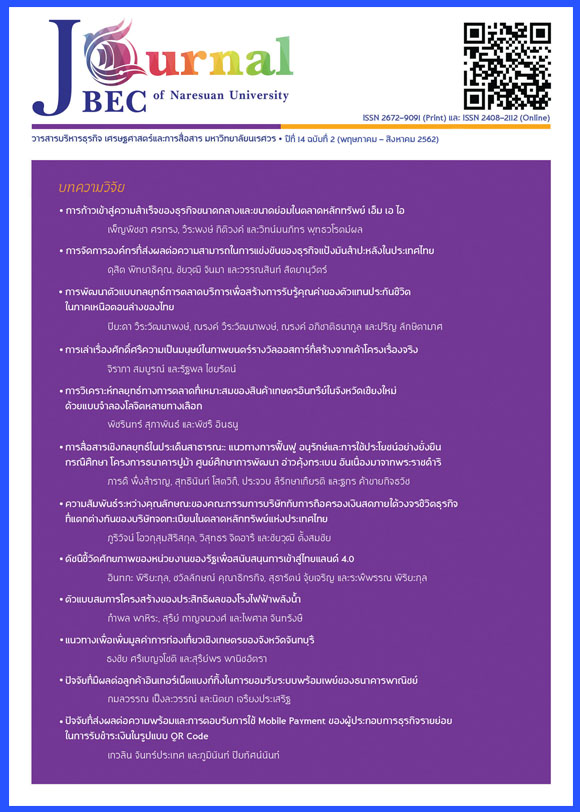The ตัวแบบสมการโครงสร้างของประสิทธิผลของโรงไฟฟ้าพลังน้ำ
Main Article Content
บทคัดย่อ
การวิจัยมีวัตถุประสงค์เพื่อพัฒนาและวิเคราะห์ตัวแบบสมการโครงสร้างของประสิทธิผลการปฏิบัติงานของพนักงานในโรงไฟฟ้าพลังน้ำ กลุ่มประชากรเป็นพนักงานโรงไฟฟ้าพลังน้ำ จำนวน 1,983 คน คัดเลือกกลุ่มตัวอย่างด้วยวิธีการสุ่มตัวอย่างแบบง่าย จำนวน 322 คน เครื่องมือการวิจัยเป็นแบบสอบถาม 4 ส่วน ได้แก่ 1) ภาวะผู้นำการเปลี่ยนแปลง 2) ทรัพยากรในงาน 3) ความผูกพันของพนักงาน และ 4) ประสิทธิผลของโรงไฟฟ้า มีค่าความเชื่อมั่นเท่ากับ 0.96, 0.83, 0.92 และ 0.86 ตามลำดับ วิเคราะห์ข้อมูลวิจัยด้วยสถิติวิเคราะห์โมเดลสมการโครงสร้าง ผลการวิจัย พบว่า ภาวะผู้นำการเปลี่ยนแปลงมีอิทธิพลทางตรงกับทรัพยากรในงาน (β = 0.67, p < 0.001) ความผูกพันของพนักงาน (β = 0.39, p < 0.05) และประสิทธิผลของโรงไฟฟ้าพลังน้ำ (β = 0.18, p < 0.05) และมีอิทธิพลทางอ้อมกับประสิทธิผลของโรงไฟฟ้าพลังน้ำ โดยผ่านทรัพยากรในงาน (β = 0.42, p < 0.05) แต่ความผูกพันของพนักงานต่อองค์กรไม่มีอิทธิพลโดยตรงต่อประสิทธิผลของโรงไฟฟ้าพลังน้ำอย่างมีนัยสำคัญทางสถิติ (p < 0.05) ตัวแบบสมการโครงสร้างของประสิทธิผลของโรงไฟฟ้าพลังน้ำ มีความสอดคล้องกับข้อมูลเชิงประจักษ์ (P-value = 0.094, Chi-Square = 80.44, df = 65, CMIN/df = 1.24, GFI = 0.97, AGFI = 0.94, CFI = 0.99, RMSEA = 0.03) โดยสามารถอธิบายความแปรปรวนของของประสิทธิผลของโรงไฟฟ้าพลังน้ำ ได้ร้อยละ 55 (R2 = 0.55) จากข้อค้นพบการวิจัยครั้งนี้ แสดงชัดว่าควรพัฒนาภาวะผู้นำการเปลี่ยนแปลงของผู้อำนวยการโรงไฟฟ้าเพื่อให้เกิดผลกับทรัพยากรในงานอันจะส่งผลในทางบวกต่อประสิทธิผลของโรงไฟฟ้าพลังน้ำ
Article Details
เอกสารอ้างอิง
2. Askary, S. H. (2013). Leadership styles and organizational effectiveness in pharmaceutical and biotechnology industries. Available from ProQuest Dissertations and Theses Global. Retrieved November 11, 2018, from https://search.proquest.com/docview/1426640178?accountid=35151
3. Bakker, A. B., Hakanen, J. J., Demerouti, E. and Xanthopoulou, D. (2007). Job resources boost work engagement, particularly when job demands are high. Journal of Educational Psychology, 99(2), 274-284.
4. Bass, B. M. and Avolio, B. J. (1994). Improving organization effectiveness through transformational leadership. Thousand Oaks: Sage.
5. Behling, O. and Law, K. S. (2000). Translating questionnaires and other research instruments: Problems and solution. London: Sage Publications.
6. Breevaart, K., Bakker, A., Hetland, J., Demerouti, E., Olsen, O. K. and Espevik, R. (2014). Daily transactional and transformational leadership and daily employee engagement. Journal of Occupational and Organizational Psychology, 87(1), 138-157.
7. Chupradist, W. (2017). The causal relationship of organizational climate, organizational citizenship behavior, employee engagement and organizational effectiveness of service business organizations. Journal of Business Administration, 6(2), 31-47.
8. Daft, R. L. (2012). Management (10th ed.). Ohio: South-Western.
9. Darawong, C. (2018). Leadership in managing new product development projects. Journal of Business, Economics and Communications, 13(2), 18-30.
10. Electricity Generating Authority of Thailand. (2016). Annual report 2016. Retrieved November 11, 2018, from https://www.egat.co.th/images/businessop/annual-report/2559/annual-report-59-th.pdf
11. Gibson, J. L., Ivancevich, J. M., Donnelly, J. H. and Konopaske, R. (2012). Organizations: Behavior, structure, processes (14th ed.). Boston: McGraw-Hill.
12. Hair, J. F., Black, W. C., Babin, B. J. and Anderson, R. E. (2007). Multivariate data analysis. A global perspective (6thed.). New Jersey: Pearson Prentice Hall.
13. Kataria, A., Garg, P. and Rastogi, R. (2014). The role of work engagement in the pursuit of organisational effectiveness. International Journal of Indian Culture and Business Management, 9(1), 37-54.
14. Macey, W. H. and Schneider, B. (2008). The meaning of employee engagement. Industrial and organizational Psychology, 1(1), 3-30.
15. Mott, P. E. (1972). The characteristics of effective organizations. New York: Harper and Row.
16. Ogihara, S. (2014). Leadership styles and organizational effectiveness in a Japanese information technology firm. Available from ProQuest Dissertations and Theses Global. Retrieved November 11, 2018, from https://search.proquest.com/docview/1426640178?accountid=35151
17. Presti, A. L. and Nonnis, M. (2014). Testing the job demands-resources model: Evidence from
a sample of Italian employees. TPM: Testing, Psychometrics, Methodology in Applied Psychology, 21(1), 89-101.
18. Schaufeli, W. B. (2015). Engaging leadership in the job demands-resources model. Career Development International, 20(5), 446-46.
19. Schaufeli, W. B., Bakker, A. B. and Salanova, M. (2006). The measurement of work engagement with a short questionnaire: A cross-national study. Educational and Psychological Measurement, 66(4), 701-716.
20. Shoosanuk, A, Ratanacoon, P and Sripornngam, T (2010). Influence of CEO transformational leadership on job satisfaction and organizational commitment in refining companies in Thailand. Research Methodology and Cognitive Science, 8(1), 52-66.
21. Tims, M., Bakker, A. B. and Xanthopoulou, D. (2011). Do transformational leaders enhance their followers' daily work engagement?. The Leadership Quarterly, 22(1), 121-131.
22. Tonesakulrungruang, L. and Samantreeporn, S. (2016). A causal relationship model of the organizational effectiveness of private hospital in Wattana district, Bangkok. SSRU Graduate Studies Journal, 2(2), 198-209.


